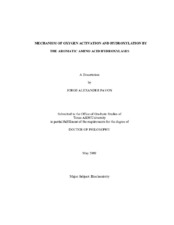| dc.description.abstract | The aromatic amino acid hydroxylases phenylalanine hydroxylase (PheH),
tyrosine hydroxylase (TyrH) and tryptophan hydroxylase (TrpH) utilize tetrahydropterin
and molecular oxygen to catalyze aromatic hydroxylation. All three enzymes have
similar active sites and contain an iron atom facially coordinated by two histidines and a
glutamate. The three enzymes also catalyze the benzylic hydroxylation of 4-
methylphenylalanine. The intrinsic primary and ?-secondary isotope effects for
benzylic hydroxylation and their temperature dependences are nearly identical for the
three enzymes, suggesting that the transition states, the tunneling contributions and the
reactivities of the iron centers are the same. When molecular oxygen and the
tetrahydropterin are replaced by hydrogen peroxide (H2O2), these enzymes catalyze the
hydroxylation of phenylalanine to form tyrosine and meta-tyrosine with nearly identical
second order rate constants. When the H2O2-dependent reaction is carried out with
cyclohexylalanine or 4-methylphenylalanine, the products are 4-HO-cyclohexylalanine
and 4-hydroxymethylphenylalanine, respectively. These experiments provide further
evidence that the intrinsic reactivities of the iron centers in these enzymes are the same. Wild-type PheH and the uncoupled mutant protein V379D exhibit normal and
inverse isotope effects, respectively, with deuterated phenylalanines. When the reaction
is monitored by stopped-flow absorbance spectroscopy, three steps are visible. The first
step is the reversible binding of O2, the second step is 5-7 fold faster than the turnover
number, setting a limiting value for the rate constant for O2 activation, and the last step
is non-enzymatic. There is no burst in the pre-steady state formation of tyrosine. These
results are consistent with formation of the new C-O bond to form tyrosine as the ratelimiting
step of the reaction.
The reaction of TrpH with both tryptophan and phenylalanine was studied by
stopped-flow absorbance spectroscopy and rapid-quench product analysis. With either
amino acid as substrate, four steps can be distinguished. The first step is the reversible
binding of O2 to the Fe(II) center; this results in an absorbance signature with a
maximum at 420 nm. This O2 complex decays with a rate constant that is 18-22 fold
faster than the turnover number with either amino acid, setting a the lower limit for the
rate constant for O2 activation. The rate constant for the third step agrees well with the
pre-steady state of formation of 5-hydroxytryptophan or tyrosine from rapid-quench
product analysis. The rate constant for the fourth step agrees well with the turnover
number. Overall, these results show that O2 activation is fast and turnover with each
amino acid is limited by hydroxylation and release of a product, with the former step
being about 4-fold faster than the latter. | en |


